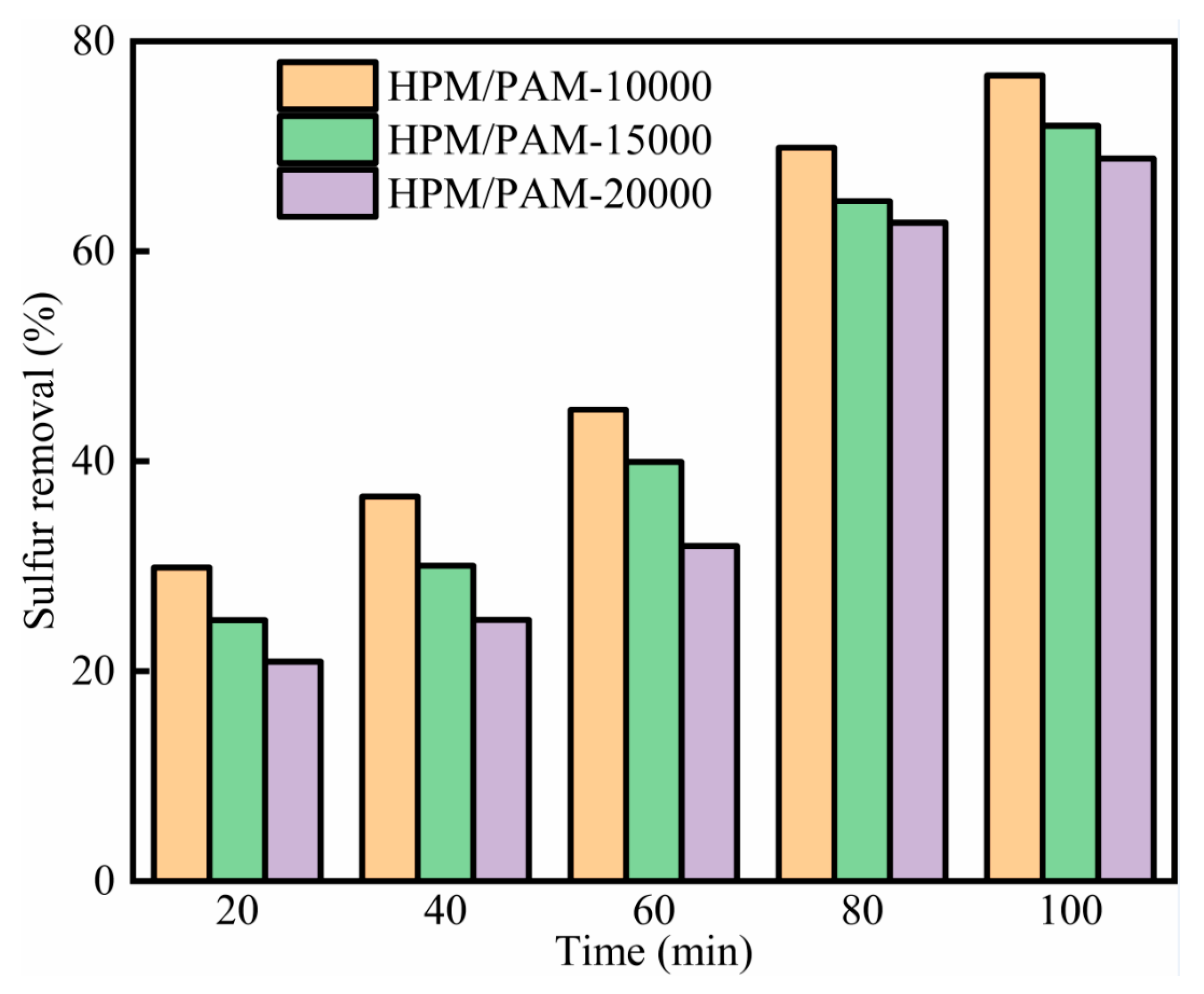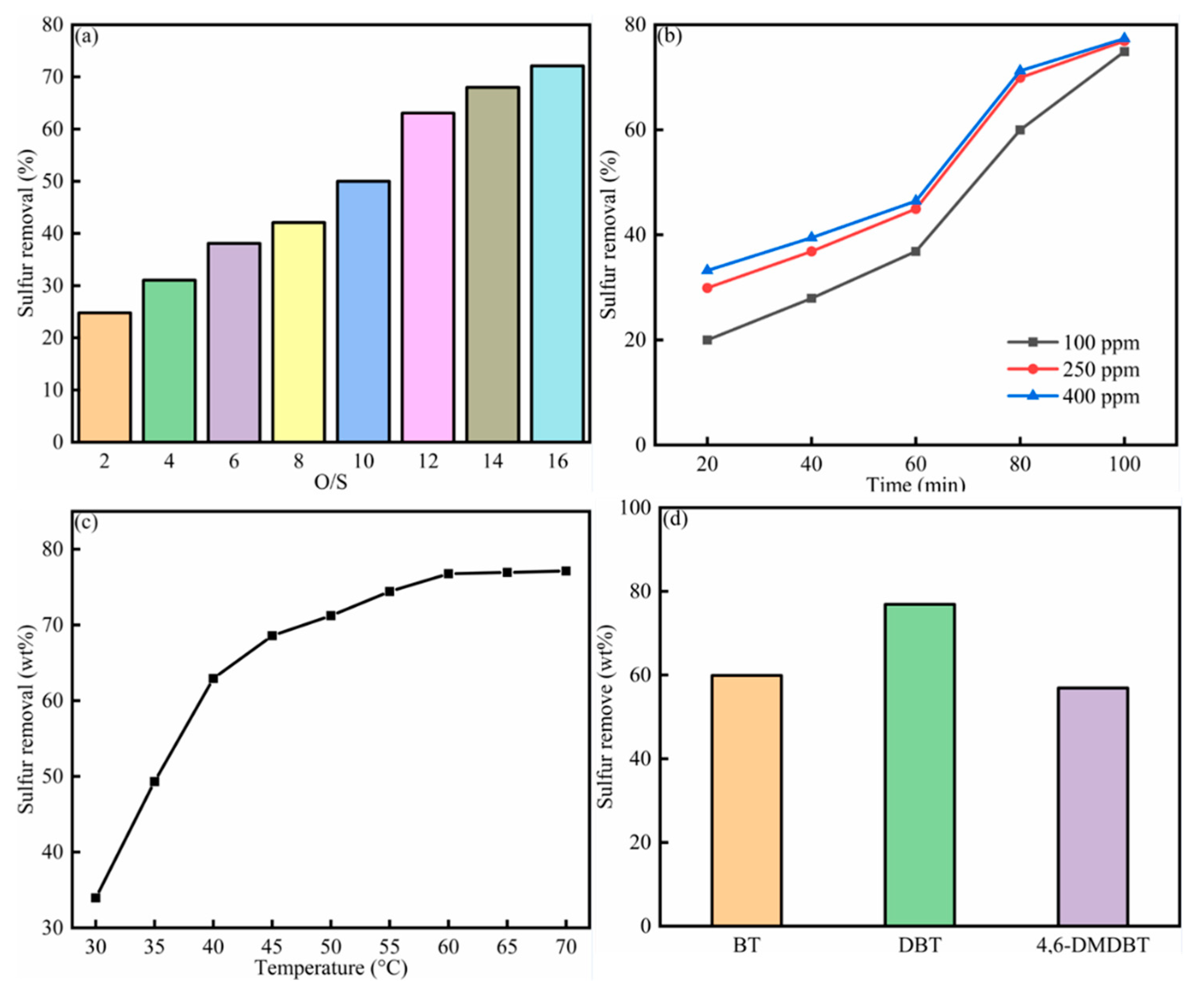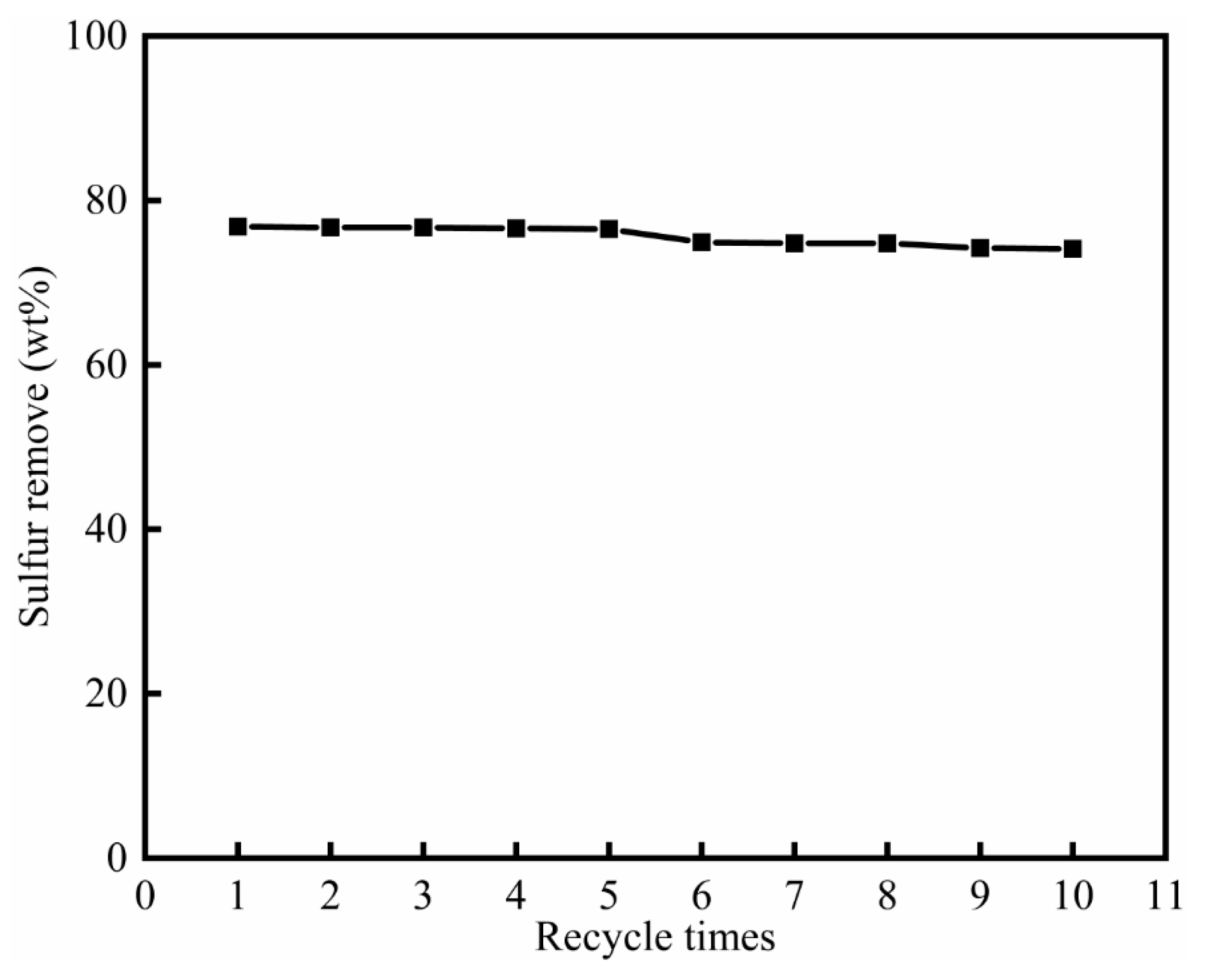HPW/PAM Catalyst for Oxidative Desulfurization-Synthesis, Characterization and Mechanism Study
Abstract
:1. Introduction
2. Experimental
2.1. Materials
2.2. Synthesis of HPW/PAM-n
2.3. Characterization
2.3.1. FTIR Measurement
2.3.2. SEM Measurement
2.4. Oxidative Desulfurization Experiment
3. Results
3.1. Characterizations of Catalysts
3.1.1. FTIR
3.1.2. SEM
3.2. Desulfurization Performance of Catalysts
4. Catalyst Recycling
5. Reaction Mechanism
6. Conclusions
- The FTIR figure showed that HPW/PAM was successfully synthesized because the characteristic peaks (-OH, -NH-) occurred. SEM results showed that when the load amount was larger, the amount of heteropoly acid would be larger, and the distributed curtain state was much more uniform.
- The catalyst desulfurization optimal process condition was as follows. The temperature was 60 °C, catalyst amount was 0.2 g, the oxygen to sulfur ratio was 16, and the reaction time is 100 min.
- The catalyst had high desulfurization efficiency after recycle use 10 times, so the catalyst stability was suitable for the industrial application.
- The mechanism for the oxidative desulfurization process was put forward. Hydrogen peroxide could produce water and oxygen. Then, after a series of reactions, the desulfurization process occurred.
- The HPW/PAM-10000 was environmentally friendly and economically feasible.
Author Contributions
Funding
Institutional Review Board Statement
Informed Consent Statement
Data Availability Statement
Conflicts of Interest
References
- Van Haandel, L.; Bremmer, G.M.; Hensen, E.J.M.; Weber, T. Influence of sulfiding agent and pressure on structure and performance of CoMo/Al2O3 hydrodesulfurization catalysts. J. Catal. 2016, 342, 27–39. [Google Scholar] [CrossRef]
- Yang, L.; Li, X.; Wang, A.J.; Prins, R.; Chen, Y.Y.; Duan, X.P. Hydrodesulfurization of dibenzothiophene, 4,6-dimethyldibenzothiophene, and their hydrogenated intermediates over bulk tungsten phosphide. J. Catal. 2015, 330, 330–343. [Google Scholar] [CrossRef]
- Jiang, B.; Yang, H.W.; Zhang, L.H.; Zhang, R.Y.; Sun, Y.L.; Huang, Y. Efficient oxidative desulfurization of diesel fuel using amide-based ionic liquids. Chem. Eng. J. 2016, 283, 89–96. [Google Scholar] [CrossRef]
- Ishihara, A.; Wang, D.H.; Dumeignil, F.; Amano, H.; Qian, E.W.H.; Kabe, T. Oxidative desulfurization and denitrogenation of a light gas oil using an oxidation/adsorption continuous flow process. Appl. Catal. A-Gen. 2005, 279, 279–287. [Google Scholar] [CrossRef]
- Gao, S.R.; Li, J.Y.; Chen, X.C.; Abdeltawab, A.A.; Yakout, S.M.; Yu, G.R. A combination desulfurization method for diesel fuel: Oxidation by ionic liquid with extraction by solvent. Fuel 2018, 224, 545–551. [Google Scholar] [CrossRef]
- Gao, S.R.; Chen, X.C.; Xi, X.T.; Abro, M.; Afzal, W.; Abro, R.; Yu, G.R. Coupled Oxidation-Extraction Desulfurization: A Novel Evaluation for Diesel Fuel. ACS Sustain. Chem. Eng. 2019, 7, 5660–5668. [Google Scholar] [CrossRef]
- Cai, Y.J.; Song, H.Y.; An, Z.; Xiang, X.; Shu, X.; He, J. The confined space electron transfer in phosphotungstate intercalated ZnAl-LDHs enhances its photocatalytic performance for oxidation/extraction desulfurization of model oil in air. Green Chem. 2018, 20, 5509–5519. [Google Scholar] [CrossRef]
- Xia, Y.T.; Li, Y.K.; Gu, Y.T.; Jin, T.; Yang, Q.; Hu, J.; Liu, H.L.; Wang, H.L. Adsorption desulfurization by hierarchical porous organic polymer of poly-methylbenzene with metal impregnation. Fuel 2016, 170, 100–106. [Google Scholar] [CrossRef]
- Menzel, R.; Iruretagoyena, D.; Wang, Y.F.; Bawaked, S.M.; Mokhtar, M.; Al-Thabaiti, S.A.; Basahel, S.N.; Shaffer, M.S.P. Graphene oxide/mixed metal oxide hybrid materials for enhanced adsorption desulfurization of liquid hydrocarbon fuels. Fuel 2016, 181, 531–536. [Google Scholar] [CrossRef]
- Xiong, J.; Yang, L.; Chao, Y.H.; Pang, J.Y.; Zhang, M.; Zhu, W.S.; Li, H.M. Boron Nitride Mesoporous Nanowires with Doped Oxygen Atoms for the Remarkable Adsorption Desulfurization Performance from Fuels. ACS Sustain. Chem. Eng. 2016, 4, 4457–4464. [Google Scholar] [CrossRef]
- Xu, J.C.; Zhang, B.; Lu, Y.K.; Wang, L.G.; Tao, W.Y.; Teng, X.; Ning, W.S.; Zhang, Z.K. Adsorption desulfurization performance of PdO/SiO2@graphene oxide hybrid aerogel: Influence of graphene oxide. J. Hazard. Mater. 2022, 421, 126680. [Google Scholar] [CrossRef] [PubMed]
- Rizzo, C.; Misia, G.; Marullo, S.; Billeci, F.; D’Anna, F. Bio-based chitosan and cellulose ionic liquid gels: Polymeric soft materials for the desulfurization of fuel. Green Chem. 2022, 24, 1318–1334. [Google Scholar] [CrossRef]
- Wang, J.; Yang, B.; Peng, X.L.; Ding, Y.C.; Yu, S.S.; Zhang, F.Q.; Zhang, L.F.; Wu, H.D.; Guo, J. Design and preparation of polyoxometalate-based catalyst [MIMPs]3PMo6W6O40 and its application in deep oxidative desulfurization with excellent recycle performance and low molar O/S ratio. Chem. Eng. J. 2022, 429, 132446. [Google Scholar] [CrossRef]
- Su, T.; Chi, M.Y.; Chang, H.Y.; Jin, Y.; Liao, W.P.; Ren, W.Z.; Zhao, D.Y.; Len, C.; Lu, H.Y. Enhanced oxidative desulfurization of fuel in ionic liquid by TiO2 quantum dots catalysts modified with Anderson-type polyoxometalate. Colloid Surf. A-Physicochem. Eng. Asp. 2022, 632, 127821. [Google Scholar] [CrossRef]
- Wang, F.; Liu, Y.F.; Lv, Y.; Ren, J.; Wang, R.X.; Jiao, W.Z. Oxidative desulfurization of liquid fuels catalyzed by W2C@C derived from metallophthalocyanine/phosphotungstic acid composites. Sep. Purif. Technol. 2022, 281, 119953. [Google Scholar] [CrossRef]
- Zhong, J.T.; Qi, Z.Y.; Liu, Y.Y.; Zhu, Y.X.; Chen, J.; Ye, C.S.; Qiu, T. Preparation of Zr-Based Phosphotungstic Acid Catalyst, ZrPTAX-BTC, and Its Application in Ultradeep and Fast Oxidative Desulfurization of Fuels. Ind. Eng. Chem. Res. 2022, 61, 977–986. [Google Scholar] [CrossRef]
- Miao, G.; Huang, D.S.; Ren, X.L.; Li, X.; Li, Z.; Xiao, J. Visible-light induced photocatalytic oxidative desulfurization using BiVO4/C3N4@SiO2 with air/cumene hydroperoxide under ambient conditions. Appl. Catal. B-Environ. 2016, 192, 72–79. [Google Scholar] [CrossRef]
- Yi, H.H.; Yang, K.; Tang, X.L.; Liu, X.; Zhao, S.Z.; Gao, F.Y.; Huang, Y.H.; Yang, Z.Y.; Wang, J.G.; Shi, Y.R. Effects of preparation conditions on the performance of simultaneous desulfurization and denitrification over SiO2-MnOx composites. J. Clean. Prod. 2018, 189, 627–634. [Google Scholar] [CrossRef]
- Zhang, J.; Sun, S.; Bian, Y.H.; Li, W.K.; Liu, R.; Zhao, D.S. Adsorptive desulfurization of metal phthalocyanine functionalized poly-ionic liquids grafted to silica gel. Fuel 2018, 220, 513–520. [Google Scholar] [CrossRef]
- Chen, Y.; Song, H.Y.; Lu, Y.Z.; Meng, H.; Li, C.X.; Lei, Z.G.; Chen, B.H. Unified Catalytic Oxidation-Adsorption Desulfurization Process Using Cumene Hydroperoxide as Oxidant and Vanadate Based Polyionic Liquid as Catalyst and Sorbent. Ind. Eng. Chem. Res. 2016, 55, 10394–10403. [Google Scholar] [CrossRef]
- Chaukura, N.; Mamba, B.B.; Mishra, S.B. Porous materials for the sorption of emerging organic pollutants from aqueous systems: The case for conjugated microporous polymers. J. Water Process Eng. 2017, 16, 223–232. [Google Scholar] [CrossRef]
- Zaidi, Z.; Sorokhaibam, L.G. Sequential Approach to Liquid Fuel Desulfurization through Rhodococcus erythropolis Assisted Molybdenum Modified Euryale ferox Biomass. Energy Fuels 2022, 36, 1615–1625. [Google Scholar] [CrossRef]
- Li, B.; Yun, Y.B.; Liu, G.C.; Li, C.L.; Li, X.Y.; Hilal, M.; Yang, W.; Wang, M.X. Direct contact membrane distillation with softening Pre-treatment for effective reclaiming flue gas desulfurization wastewater. Sep. Purif. Technol. 2021, 277, 119637. [Google Scholar] [CrossRef]
- Yen, H.Y.; Yang, M.H. Modified solution-diffusion model analysis of the flue gas desulfurization effluents in a polyamide membrane. Polym. Test. 2003, 22, 109–113. [Google Scholar] [CrossRef]
- Yu, S.N.; Jiang, Z.Y.; Yang, S.; Ding, H.; Zhou, B.F.; Gu, K.; Yang, D.; Pan, F.S.; Wang, B.Y.; Wang, S.; et al. Highly swelling resistant membranes for model gasoline desulfurization. J. Membr. Sci. 2016, 514, 440–449. [Google Scholar] [CrossRef]
- Wang, D.H.; Qian, E.W.H.; Amano, H.; Okata, K.; Ishihara, A.; Kabe, T. Oxidative desulfurization of fuel oil–Part I. Oxidation of dibenzothiophenes using tert-butyl hydroperoxide. Appl. Catal. A-Gen. 2003, 253, 91–99. [Google Scholar] [CrossRef]
- Liu, Y.B.; Chu, J.F.; Lian, L.F.; Chen, X.; An, S.; Hong, L.L.; Wang, D.Q.; Chen, W. Ultrafast Oxidative Desulfurization of Diesel Fuels by Mass Transfer Enhancement of Polyoxometalate Modified Alumina Catalysts. Energy Fuels 2021, 35, 2110–2120. [Google Scholar] [CrossRef]
- Lu, C.Z.; Fu, H.; Li, H.P.; Zhao, H.; Cai, T.F. Oxidation-extraction desulfurization of model oil over Zr-ZSM-5/SBA-15 and kinetic study. Front. Chem. Sci. Eng. 2014, 8, 203–211. [Google Scholar] [CrossRef]
- Masoomi, M.Y.; Bagheri, M.; Morsali, A. Application of Two Cobalt-Based Metal-Organic Frameworks as Oxidative Desulfurization Catalysts. Inorg. Chem. 2015, 54, 11269–11275. [Google Scholar] [CrossRef]
- Abazari, R.; Sanati, S.; Morsali, A.; Slawin, A.; Carpenter-Warren, C.L. Dual-Purpose 3D Pillared Metal-Organic Framework with Excellent Properties for Catalysis of Oxidative Desulfurization and Energy Storage in Asymmetric Supercapacitor. ACS Appl. Mater. Interfaces 2019, 11, 14759–14773. [Google Scholar] [CrossRef]
- Majid, M.F.; Zaid, H.F.M.; Kait, C.F.; Jumbri, K.; Lim, J.W.; Masri, A.N.; Ghani, S.M.M.; Yamagishi, H.; Yamamoto, Y.; Yuliarto, B. Liquid Polymer Eutectic Mixture for Integrated Extractive-Oxidative Desulfurization of Fuel Oil: An Optimization Study via Response Surface Methodology. Processes 2020, 8, 848. [Google Scholar] [CrossRef]
- Kulikov, L.A.; Akopyan, A.V.; Polikarpova, P.D.; Zolotukhina, A.V.; Maximov, A.L.; Anisimov, A.V.; Karakhanov, E.A. Catalysts Based on Porous Polyaromatic Frameworks for Deep Oxidative Desulfurization of Model Fuel in Biphasic Conditions. Ind. Eng. Chem. Res. 2019, 58, 20562–20572. [Google Scholar] [CrossRef]
- Wang, C.; Li, A.-R.; Ma, Y.-L. Phosphomolybdic acid niched in the metal-organic framework UiO-66 with defects: An efficient and stable catalyst for oxidative desulfurization. Fuel Process. Technol. 2021, 212, 106629. [Google Scholar] [CrossRef]
- Li, A.; Song, H.; Meng, H.; Lu, Y.; Li, C. Poly(ionic liquid)s based nano core-shell catalyst SiO2@V-PIL for efficient oxidative desulfurization of diesel. Appl. Catal. A Gen. 2021, 616, 118096. [Google Scholar] [CrossRef]
- Doustkhah, E.; Mohtasham, H.; Hasani, M.; Ide, Y.; Rostamnia, S.; Tsunoji, N.; Assadi, M.H.N. Merging periodic mesoporous organosilica (PMO) with mesoporous aluminosilica (Al/Si-PMO): A catalyst for green oxidation. Mol. Catal. 2020, 482, 110676. [Google Scholar] [CrossRef]
- Wei, S.N.; He, H.J.; Cheng, Y.; Yang, C.P.; Zeng, G.M.; Qiu, L. Performances, kinetics and mechanisms of catalytic oxidative desulfurization from oils. RSC Adv. 2016, 6, 103253–103269. [Google Scholar] [CrossRef]
- Li, X.Z.; Zhu, W.; Lu, X.W.; Zuo, S.X.; Yao, C.; Ni, C.Y. Integrated nanostructures of CeO2/attapulgite/g-C3N4 as efficient catalyst for photocatalytic desulfurization: Mechanism, kinetics and influencing factors. Chem. Eng. J. 2017, 326, 87–98. [Google Scholar] [CrossRef]
- Yu, F.L.; Wang, Q.Y.; Yuan, B.; Xie, C.X.; Yu, S.T. Alkylation desulfurization of FCC gasoline over organic-inorganic heteropoly acid catalyst. Chem. Eng. J. 2017, 309, 298–304. [Google Scholar] [CrossRef]
- Li, S.W.; Gao, R.M.; Zhao, J.S. Deep Oxidative Desulfurization of Fuel Catalyzed by Modified Heteropolyacid: The Comparison Performance of Three Kinds of Ionic Liquids. ACS Sustain. Chem. Eng. 2018, 6, 15858–15866. [Google Scholar] [CrossRef]
- Jiang, W.; Zhu, W.S.; Chang, Y.H.; Chao, Y.H.; Yin, S.; Liu, H.; Zhu, F.X.; Li, H.M. Ionic liquid extraction and catalytic oxidative desulfurization of fuels using dialkylpiperidinium tetrachloroferrates catalysts. Chem. Eng. J. 2014, 250, 48–54. [Google Scholar] [CrossRef]
- Zhao, W.T.; Zheng, X.H.; Liang, S.J.; Zheng, X.X.; Shen, L.J.; Liu, F.J.; Cao, Y.N.; Wei, Z.; Jiang, L.L. Fe-doped-Al2O3 porous hollow microspheres for enhanced oxidative desulfurization: Facile fabrication and reaction mechanism. Green Chem. 2018, 20, 4645–4654. [Google Scholar] [CrossRef]






| Catalyst | Sulfur Content (ppm) | Temperature (°C) | Time (min) | O/S | Sulfur Removal (%) | Reference |
|---|---|---|---|---|---|---|
| Nb2O5/Al2O3 | 55 | 110 | 180 | 1.5 | 43.42 | [26] |
| Al2O3-P2W15-C18 | 1000 | 60 | 9 | 3 | 100 | [27] |
| Ag-ZSM5/SBA-15 | 1000 | 70 | 120 | - | 44 | [28] |
| TMU-10 | 500 | 60 | 360 | 3 | 74.7 | [29] |
| NH2-TMU-53 | 500 | 60 | 120 | 3 | 79.4 | [30] |
| DES | 100 | 25 | - | 2 | 79.01 | [31] |
| PAF-30-W | 500 | 60 | 120 | 6 | 60 | [32] |
| 0.5-HPMo@UiO-66-D | 800 | 60 | 60 | 8 | 100 | [33] |
| SiO2@V-PIL-70 | 500 | 50 | 90 | 5 | 99 | [34] |
| Cu@Al-PMO-TU | - | 120 | 25 | - | 100 | [35] |
Publisher’s Note: MDPI stays neutral with regard to jurisdictional claims in published maps and institutional affiliations. |
© 2022 by the authors. Licensee MDPI, Basel, Switzerland. This article is an open access article distributed under the terms and conditions of the Creative Commons Attribution (CC BY) license (https://creativecommons.org/licenses/by/4.0/).
Share and Cite
Zheng, Z.; Wu, Q.; Zhong, S. HPW/PAM Catalyst for Oxidative Desulfurization-Synthesis, Characterization and Mechanism Study. Processes 2022, 10, 402. https://doi.org/10.3390/pr10020402
Zheng Z, Wu Q, Zhong S. HPW/PAM Catalyst for Oxidative Desulfurization-Synthesis, Characterization and Mechanism Study. Processes. 2022; 10(2):402. https://doi.org/10.3390/pr10020402
Chicago/Turabian StyleZheng, Ziyang, Qian Wu, and Shengyang Zhong. 2022. "HPW/PAM Catalyst for Oxidative Desulfurization-Synthesis, Characterization and Mechanism Study" Processes 10, no. 2: 402. https://doi.org/10.3390/pr10020402






